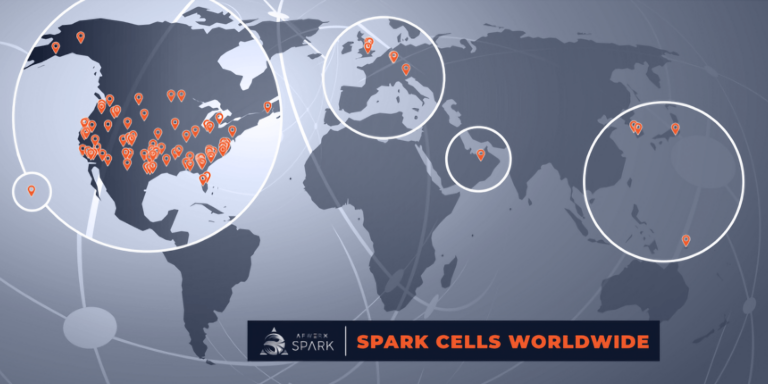Joint Base Andrews (JBA), the installation in Prince George’s County, Maryland that is operated by the US Air Force (USAF) and serves as a base for air combat units from all across the Department of Defense (DoD), has begun hosting a course in 3D printing. The course is run by Spark X Cell, an innovation laboratory located on JBA that provides units there with advanced manufacturing and tech development and support services.
Opened in 2019, Spark X is part of the USAF accelerator AFWERX’s ‘Spark cell network’, a decentralized, global network dedicated to innovation. Spark X’s first class took place on December 1, with plans for a new class each month depending on participation levels.
Illustrating the extent to which the military’s interest in additive manufacturing (AM) R&D goes far beyond use of the technology for munitions production, USAF Tech. Sgt. Matt Hettwer joined the class in order to learn how to print parts for an electric trombone. Hettwer, who says he is not “super well versed in 3D printing yet”, specifically hopes to learn how to print a Musical Instrument Digital Interface (MIDI)-controller in the course, suggesting Spark X Cell contains the equipment necessary for 3D printed electronics.

USAF Staff Sgt. Chad Bohr, who taught the first class, told DVIDS, “My entire role is to make sure we’re empowering airmen to help create solutions to the problems in their work areas. Being able to say bring an item that was no longer made, but we have somebody here that can design that.”
The superintendent of Spark X Cell, USAF Tech Sgt. Jakob Miller, said, “Currently the class is open to all Active, Guard, and Reserve military members and military civilian personnel. There are no rank or AFSC/MOS requirements, just a drive to learn a new skill and be the next great military innovator. This class is a steppingstone for Airmen to help bring their skills in technology to life through a physical product that can have operational impacts. While not all units have 3D printing capabilities yet, class attendees will now have a better understanding when they utilize these services at Spark X or one of the many other Spark Cells across the Air Force. Airmen using these tools can help solve problems in their unit and the Air Force, showing dedication to the mission outside of their daily work.”

The Spark X course is nearly identical to one I mentioned in an article from June 2023, “US Military Innovation Pushed to the Frontlines with Advanced Manufacturing”. That class, which was formed in March 2023, takes place at the US Army’s 82nd Airborne Division at Fort Bragg, in the installation’s Airborne Innovation Lab. The Fort Bragg course is also designed to be open to all servicemembers regardless of rank or occupational specialty.
Above the specific end-use parts produced, these courses highlight the most urgent priority driving the US military’s interest in AM: workforce development for the US manufacturing base. The Department of Energy recently released the report, Options for a National Plan for Smart Manufacturing, and the webinar about the release largely revolved around the need for comprehensive workforce training efforts.
The DoD was set to release its National Defense Industrial Strategy this month, although that release has been postponed until January. But a pre-decisional draft of the report also highlights workforce development as one of the biggest challenges the US government faces in its attempt to reshore manufacturing.
CEO of consultancy BMNT, Peter Newell, highlighted this issue in the recent interview I did with him, and the US Navy’s Executive Director of Program Executive Office, Strategic Submarines, Matthew Sermon, has been on a veritable crusade about workforce development all year. Finally, you can read about the topic extensively in “Additive Manufacturing for the Military and Defense”, the AM Research report I co-wrote with Tali Rosman.
It seems almost guaranteed, that not only will a substantial proportion of the next generation of AM workers come from the US military, but even more critically, that the US’s entire next generation model for manufacturing workforce development will be largely predicated on the US military’s buildup of its AM labor pool. If there’s one thing the US military still has the assets and know-how to succeed at as well as anyone else, it’s workforce development: to succeed at that task for the manufacturing sector in the 21st century, the US military needs 3D printers.
Images courtesy of DVIDS
Subscribe to Our Email Newsletter
Stay up-to-date on all the latest news from the 3D printing industry and receive information and offers from third party vendors.
You May Also Like
Further Understanding of 3D Printing Design at ADDITIV Design World
ADDITIV is back once again! This time, the virtual platform for additive manufacturing will be holding the first-ever edition of ADDITIV Design World on May 23rd from 9:00 AM –...
3D Printer Maker EVO-tech Reborn as NEVO3D — Once More With Feeling
EVO-tech was a 3D printing service and original equipment manufacturer established in 2013 and based in Schörfling am Attersee, Austria. The company produced high-quality material extrusion systems featuring linear bearings,...
3D Systems Brings 3D Printed PEEK Cranial Implant to the U.S. with FDA Clearance
For more than 10 years, 3D Systems (NYSE:DDD) has worked hand-in-hand with surgeons to plan over 150,000 patient-specific cases, and develop more than two million instruments and implants from its...
CDFAM Returns to Berlin for Second Annual Symposium
The second CDFAM Computational Design Symposium is scheduled for May 7-8, 2024, in Berlin, and will convene leading experts in computational design across all scales. Building upon the first event...































